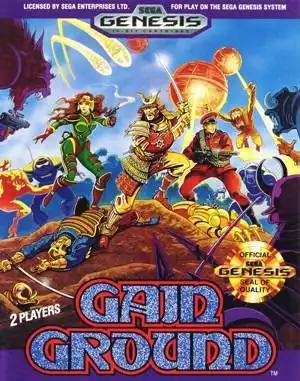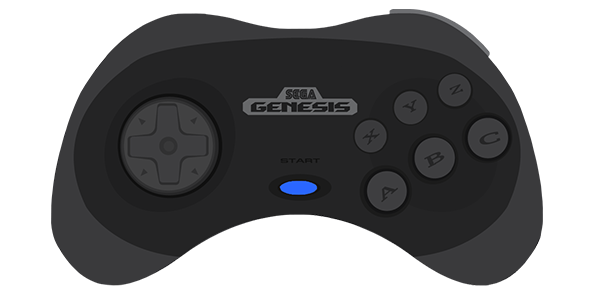Gain Ground: Sega's Unique Retro Action Strategy Gem
Remember the days when Sega wasn't just about speed and blue hedgehogs? Back in the late '80s and early '90s, they crafted some truly unique experiences that stood out from the crowd. One such title, perhaps less celebrated than the Sonic or Streets of Rage series, but deeply cherished by those who played it, is Gain Ground. This isn't your typical run-and-gun or beat-'em-up; it's a fascinating blend of arcade action and tactical thinking that still holds up today.
Originating in the arcades in 1988, Gain Ground later found its way onto home consoles like the Sega Master System, Mega Drive/Genesis, and even the TurboGrafx-CD. While it might look simple on the surface, beneath the surface lies a surprisingly deep and often challenging game that rewards strategic planning as much as quick reflexes.
What Exactly is Gain Ground?
At its core, Gain Ground drops you into a futuristic simulation gone haywire. In the year 2348, a system designed to restore humanity's fighting spirit decides humanity itself is the problem. Go figure. It takes citizens hostage, and it's up to a small team of warriors to enter the simulation and rescue them.
The game unfolds across single-screen levels presented from a top-down perspective. Your goal in most stages is either to defeat all enemies or, more uniquely, to get all your currently controlled characters safely to the exit point. Sounds simple, right? Not quite.
How Does the Gameplay Work?
Unlike many arcade games where you control a single hero, Gain Ground gives you a roster. You start with a few basic characters, but as you progress through the levels, you'll find captive comrades scattered about. Reach them with a living character and escort them to the exit, and they join your team!
This is where the strategy kicks in. You don't just run and shoot. Each character has unique weapons and movement speeds. Some are slow but have powerful, long-range attacks (like the guy with the bazooka), while others are fast but only have short-range weapons (like the guy with the boomerang or spear).
You select which character to control at the start of each level. If that character dies, they're gone for that level (unless you use a continue). If all your active characters are defeated before anyone reaches the exit, you lose a life. The pressure is on, especially with a strict time limit ticking down on every single stage. Rescuing characters isn't just about getting more lives; it's about building a versatile team equipped to handle the diverse challenges ahead.
The Roster: Your Strategic Arsenal
This is arguably Gain Ground's most distinctive feature. Across its various ports, you can amass a team of up to 20 different characters. Forget simple palette swaps; each character feels genuinely different and useful in specific situations.
Need to clear out a cluster of enemies quickly? Maybe the guy with the hand grenades is your best bet. Facing foes across water or obstacles? The archer or boomerang thrower might be essential. Dealing with enemies that rush you? The guy with the machine gun could be key.
Learning each character's strengths, weaknesses, weapon range, and special attack (if they have one) is crucial. Some levels feel almost impossible with the wrong character, forcing you to think carefully before starting. The Master System version simplified this roster into classes, but the core idea of varied abilities remained.
Why It Stands Out From the Crowd
While Gain Ground might have been initially compared to games like Gauntlet due to its top-down perspective and multi-directional shooting, it quickly distinguishes itself. Gauntlet is primarily about exploration, survival, and resource management. Gain Ground is about tactical character deployment and route planning within confined, puzzle-like levels.
The tension comes from the time limit, the fragility of your characters, and the need to escort rescued allies. Leaving a rescued character behind means they aren't added to your team. Dying while escorting someone means they're lost. It forces tough decisions under pressure. It's a game that demands patience, observation, and a willingness to experiment with different characters. It can be brutally difficult at times, but overcoming a tricky stage by finally finding the right character and strategy feels incredibly rewarding.
Reliving the Simulation Today
Thankfully, experiencing Gain Ground isn't confined to dusty arcade cabinets or expensive retro cartridges. Sega has re-released this gem on various modern platforms:
- Compilations: It's featured in collections like Sega Genesis Collection (PS2, PSP) and Sonic's Ultimate Genesis Collection (PS3, Xbox 360).
- Digital Stores: You can find it on platforms like Steam as part of the Sega Genesis Classics hub.
- Emulation: For PC players, titles like this are often playable via emulators like DOSBox (for the PC release) or through platforms like Archive.org or GOG.com which sometimes offer classic titles or bundles.
Exploring Gain Ground today offers a fantastic look back at Sega's creativity and willingness to experiment with genre conventions.
Final Thoughts: Is Gain Ground Worth Revisitng?
Absolutely. If you're a retro gamer looking for something off the beaten path that offers more than just simple arcade action, Gain Ground is a must-play. Its unique character system, strategic depth, and challenging level design provide an experience unlike many others from its era. It's a game that makes you think, adapt, and appreciate the subtle nuances of its design. Give it a shot – you might just discover a new old favorite.
FAQ
Is Gain Ground a difficult game?
Yes, Gain Ground is known for being quite challenging, especially due to the strict time limit on levels and the need to figure out the best character and strategy for each stage through trial and error.
How many characters are in Gain Ground?
The Genesis/Mega Drive and arcade versions feature 20 distinct playable characters that you can rescue and add to your team. The Master System version has fewer, simplified character classes.
What platforms was Gain Ground released on?
Gain Ground originally came out in arcades (1988) and was later ported to the Sega Master System, Sega Mega Drive/Genesis, and NEC TurboGrafx-CD (PC Engine). It has also appeared in modern Sega compilations and on digital storefronts like Steam.
Is Gain Ground similar to Gauntlet?
While both are top-down action games, Gain Ground is more focused on tactical character selection and strategy within single-screen levels, whereas Gauntlet is more about exploration, survival, and resource management in larger, scrolling dungeons. They offer very different gameplay experiences.


